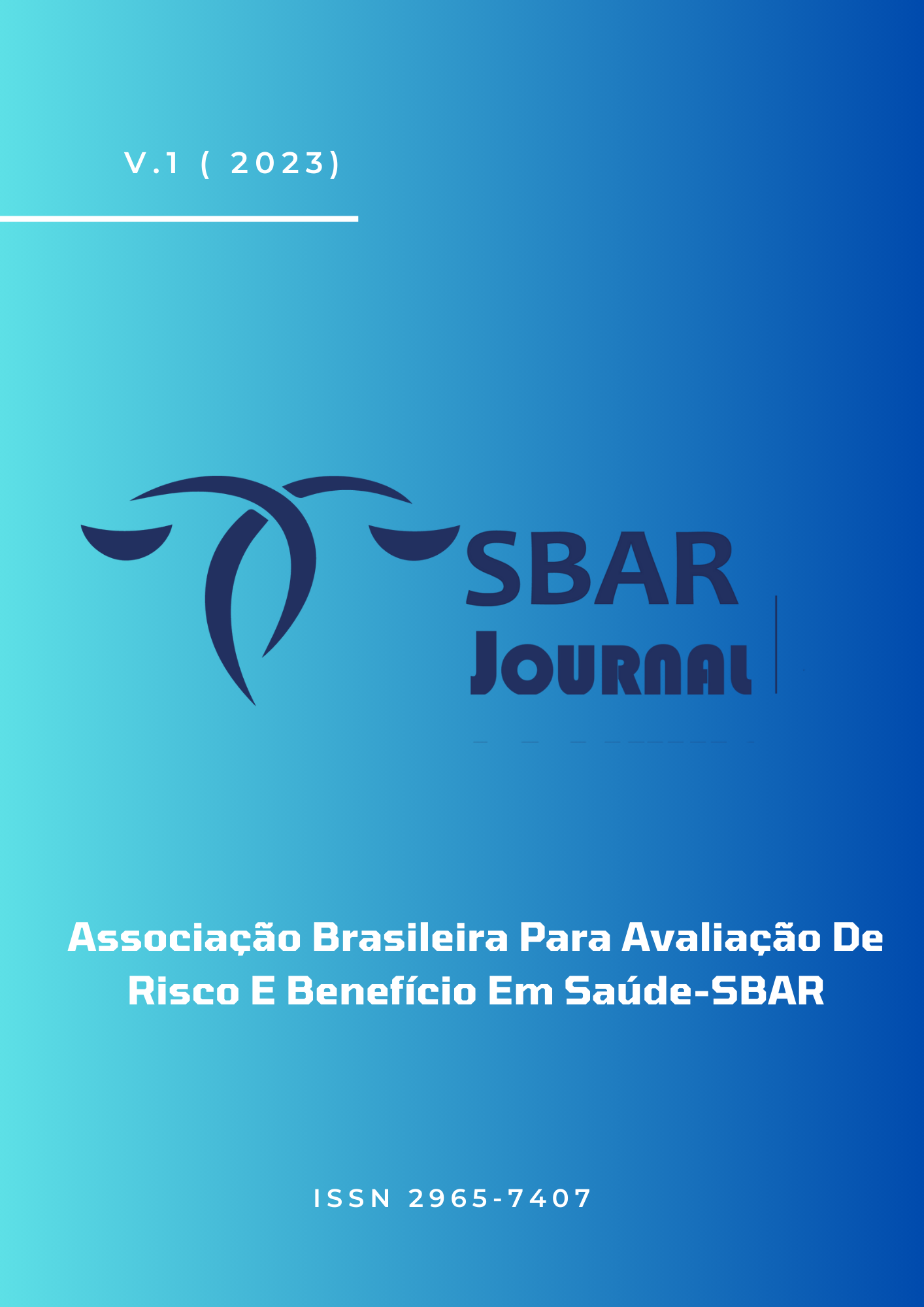Risk in outpatient surgery: a retrospective study
Risk in outpatient surgery
Abstract
Surgical site infections represent one of the main risks to patient safety in health services. Objective : To verify the incidence of surgical site infection (SSI) in clean surgeries performed in a day hospital (HD). Method: historical cohort study consisting of 128,478 patients operated on in an HD in Salvador, BA, between 2012 and 2022. Results: in the years studied, the HD epidemiological surveillance system monitored a percentage of 83% of patients after discharge, which is considered significant in identifying adverse events after surgical procedures. A total of 67,120 clean surgeries were performed, representing 52% of all surgeries monitored. The incidence of SSI in clean surgeries during the study years ranged from 0.3 to 0.8%, with a mean incidence of 0.5%, indicators that are significantly lower than those recommended for clean surgeries and for patients operated on in conventional hospitals. Conclusion: the incidence of SSI found in the HD studied reveals not only the surgical safety of this service, but also shows that these rates are much lower than those reported for patients operated in the conventional hospitalization modality, confirming that outpatient surgery carries a lower risk of acquiring infection. However, a follow-up system for patients after discharge is a sine qua non condition for knowledge, prevention, and management of diseases related to surgical procedures.
Keywords: Surgical wound infection. Day hospital. Risk. Patient safety.
References
CALEGARI IB, RAPONE MBG, PACHECO FA, BARICHELLO E, HAAS VJ, BARBOSA MH. Adherence to measures to prevent surgical site infection in the perioperative period: a cohort study. Rev enferm UERJ. V 29, p. 29:e62347, 2021. https://doi.org/10.12957/reuerj.2021.62347
CARVALHO RLR, CAMPOS CC, FRANCO LMC, ROCHA AM, ERCOLE FF. Incidência e fatores de risco para infecção do sítio cirúrgico em cirurgias gerais. Rev Latino-Am Enferm. v 25, p. e2848, 2017; https://doi.org/ 10.1590/1518-8345.1502.2848.
SOUZA ISB, SANATNA AC, A’FONSO J. G. A ocorrência de infecção do sítio cirúrgico: um estudo de revisão. Rev Med Minas Gerais v 28, (Supl 5):eS280521, 2018. https://doi.org/ 10.5935/2238-3182.20180133d.
GERBER JS, ROSS RK, SZYMCZAK JE, XIAO R, LOCALIOo AR, GRUNDMEWIER RW. Infections after pediatric ambulatory surgery: Incidence and risk factors. Infect Control Hosp Epidemiol. V 40, n. 2, p. 150-157, 2019. https://doi.org/ 10.1017/ice.2018.211.
STEFANI L, BORGES PKO, ROCHA MD. Infecções de sítio cirúrgico: reabordagem cirúrgica e infecção em cirurgias limpas e potencialmente contaminadas. Rev. Enferm. UFSM. v 12 (e12), p. 1-18, 2022. https://doi.org/10.5902/2179769267474
RINKE ML, BUNDY DG, HEO M, SAIMAN L, RABIN B, ZACHARIAH P. et al.Pediatric surgical site infection (SSI) following ambulatory surgery: Incidence, risk factors and patient outcomes. Infect Control Hosp Epidemiol. V 43, n. 8, p. 1036-1042. 2022.: https://doi.org/10.1017/ice.2021.279.
PIVOT D, HOCH G, ASTRUC K, LEPELLETIER D, LEFEBVRE A, LUCET JC. et al. A systematic review of surgical site infections following day surgery: a frequentist and a Bayesian meta-analysis of prevalence. J. Hosp Infect. v.101, n.2, p. 196-209. 2019;. https:// doi.org/10.1016/j.jhin.2018.07.035
CENTERS FOR DISEASE CONTROL AND PREVENTION. National Healthcare Safety Network. Surgical Site Infection Event. Atlanta : CDC, 2023. Disponível em: https://www.cdc.gov/nhsn/pdfs/pscmanual/9pscssicurrent.pdf
WORLD HEALTH ORGANIZATION. Global Guidelines for the Prevention of Surgical Site Infection. Geneva: OMS, 2018. Disponível em: https://www.who.int/publications/i/item/9789241550475
AGÊNCIA NACIONAL DE VIGILÂNCIA SANITÁRIA. Medidas de Prevenção de Infecção Relacionada à Assistência à Saúde. In: Brasil. Agência Nacional de Vigilância Sanitária. Medidas de Prevenção de Infecção Cirúrgica. Brasília: ANVISA 2017. [cited 2020 Sep 02]. Available from:http://portal.anvisa.gov.br/documents/33852/3507912/Caderno+4++Medidas+de+Preven%C3%A7%C3%A3o+de+Infec%C3%A 7%C3%A3o+Relacionada+%C3%A0+Assist%C3%AAncia+%C3%A0+Sa%C3%BAde/a3f23dfb-2c54-4e64-881cfccf9220c373.
AGÊNCIA NACIONAL DE VIGILÂNCIA SANITÁRIA. Critérios diagnósticos de infecção relacionada à assistência à saúde. Volume 2. 2ª. Ed. Brasília: ANVISA; 2017.
BERRIOS-TORRES SI, UMSCHEID CA, BRATZLER DW, LEAS B, STONE EC, KELZ RR. et al. Centers for Disease Control and Prevention Guideline for the Prevention of Surgical Site Infection, 2017. JAMA Surg. [Internet]. V.152, n.8, p. 784-91, 2017. https://doi.org/10.1001/jamasurg.2017.0904.
SEIDELMAN JL, MANTYLH CR, ANDERSON DJ. Surgical Site Infection Prevention. A Review. JAMA. v 29, n.3, p.244-252, 2023. https://doi.org/10.1001/jama.2022.24075
COSTA AC, SANTA-CRUZ F, FERRAZz AAB. O que há de novo em infecção do sítio cirúrgico e antibioticoprofilaxia em cirurgia?. ABCD Arq Bras Cir Dig. v. 33, n.4:e1558, 2020. https://doi.org/10.1001/jama.2022.24075/10.1590/0102-672020200004e1558
BADIA JM, CASEY AL, PETROSILLO N, HUDSON PM, MITCHELL AS, CROSBY C. Impact of surgical site infection on healthcare costs and patient outcomes: a systematic review in six European countries. Journal oh Hospital Infection. V.96, p. 1-15, 2017. https://doi.org/10.1016/j.jhim.2017.03.004.
ALEMAYEHU MA, AZENE AG, MIHRETIE KM. Time to development of surgical site infection and its predictors among general surgery patients admitted at specialized hospitals in Amhara region, northwest Ethiopia: a prospective follow‑up study. BMC Infectious Diseases. v.23, n.334, 2023. https://doi.org/10.1186/s12879-023-08301-0
PRATES CG, STADINIK CMB, BAGATINI A, CAREGNATO RCA, MOURA GMSS. Comparação das taxas de infecção cirúrgica após implantação do checklist de segurança. Acta Paul Enferm. v.31, n.2, p.116-22, 2018. https://doi.org/10.1590/1982-0194201800018
OLSEN MA, TIAN F, WALLACE AE, NICKEL KB, WARREN DK, GRASER VJ. et al. Use of quantile regression to determine the impacto n total health care costs of surgical site infections following common ambulatoty procedures. Ann Surg. V.12, 2017. https://doi.org/:10.1097/SLA.0000000000001590.
HARRISON EM. Surgical site infection after gastrointestinal surgery in high-income, middle-income, and low-income countries: a prospective, international, multicentre cohort study. The Lancet. v.18, .2018. http://dx.doi.org/10.1016/ S1473-3099(18)30101-4






